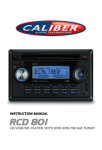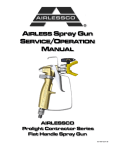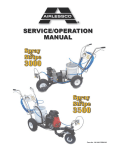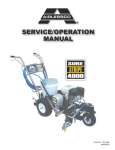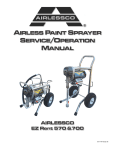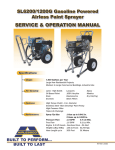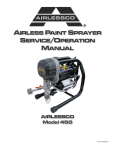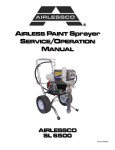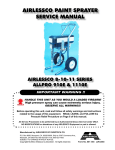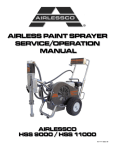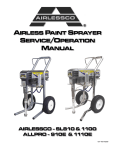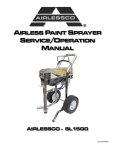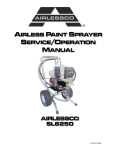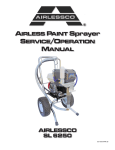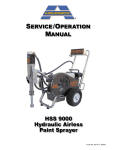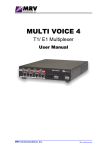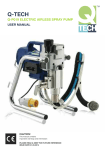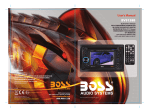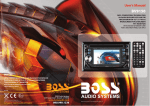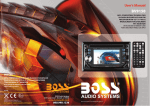Download AIRLESSCO 3000, 3500 Instruction manual
Transcript
® AIRLESS PAINT LINE STRIPER SERVICE/OPERATION MANUAL Spray and Stripe 3000 001-703 DEC 08 TABLE OF CONTENTS SECTION Introduction...................................................... 1 Safety Warnings .............................................. 2 Setting Up........................................................ 5 Flushing ........................................................... 5 How to Flush ................................................... 6 Starting Up ...................................................... 7 Pressure Relief Procedure .............................. 8 Daily Maintenence ........................................... 8 Line Striping Operation.................................... 9 Airless Spray Gun Operation......................... 10 Airless Spray gun Assembly ...........................11 Airless Spray Gun Troubleshooting ............... 12 Rev Tips ........................................................ 13 Field Troubleshooting .................................... 13 Servicing Fluid Pump .................................... 14 Servicing Outlet Valve ................................... 15 Servicing Inlet Valve ...................................... 15 Packing Replacement Procedures ................ 16 Inspection/Replacement of Control Valve...... 18 Pressure Control Calibration ......................... 18 Bypass Valve Assembly................................. 19 Gearbox Assembly ........................................ 20 Frame Assembly............................................ 21 Spray Gun Assembly ..................................... 22 Gun Mount Assembly .................................... 22 Suction Assembly .......................................... 23 Striping Accessories ...................................... 24 Notes ............................................................. 25 Airlessco Accessories.................................... 26 Airlessco 5397 N. Commerce Ave, Moorpark, CA 93021 www.airlessco.com • (805) 523-0211 2 FIGURE 1 Filling the Packing Nut/Wet Cup................ 5 2. Spray Tip ................................................... 6 3. Control Valve ............................................. 6 4. Choke, Fuel Throttle .................................. 6 5. Static Discharge ........................................ 6 6. Gun Safety Latch..................................... 10 7. Major Gun Components .......................... 10 8. Spray Tip ................................................. 10 9. Spray Tip Assembly ................................. 10 10. Airless Spray Gun Assembly ....................11 11. Fluid Pump............................................... 14 12. Outlet Valve ............................................. 15 13. Inlet Valve ................................................ 15 14. Packing.................................................... 16 15. Packing Cutaway..................................... 17 16. Bypass Valve Assembly........................... 19 17. Gearbox Assembly .................................. 20 18. Frame Assembly...................................... 21 19. Spray Gun Assembly ............................... 23 20. Gun Mount Assembly .............................. 23 21. Suction Assembly .................................... 23 INTRODUCTION The Spray & Stripe 3000 is a mobile airless sprayer designed to be used and strong enough to stripe parking lots yet light on it’s wide tires to stripe sports fields. Plus it’s based on a contractor quality paint spray pump so the gun can be snapped out of its holder and can be used as a mobile airless painting system for general exterior painting. Built on a compact, well balanced frame, with “No Tools” removable handlebars, the 3000 combines a dependable commercial 4-cycle engine, and the proven durability of our LP “Slow-Stroking” stainless steel piston paint pump. Forget about stripers that lack the power to spray pure paint. The 3000 is H2NO READY!, so you don’t have to figure out how much water to add to the paint to properly atomize at the pressure designed into the sprayer. You simply just adjust the 3000’s pressure control knob for optimal atomiziation of pure paint, or the water/paint mix that you want to spray or stripe with. SS3000 Part No. 305-401 Max Pressure 1500 PSI Output (At Pressure) 0.62 GPM Tip Size 1 Gun 0.025 in. Motor Durotech 4HP Weight WARNING 162 lbs HANDLE THIS UNIT AS YOU WOULD A LOADED FIREARM! HIGH PRESSURE SPRAY CAN CAUSE EXTREMELY SERIOUS INJURY. OBSERVE ALL WARNINGS! MANUAL NOTATIONS WARNING - Alerts user to avoid or correct conditions that could cause bodily injury. CAUTION - Alerts user to avoid or correct conditions that could cause damage to or destruction of equipment. BEFORE OPERATING THIS UNIT, READ AND FOLLOW ALL SAFETY WARNINGS AND INSTRUCTIONS RELATED TO THE USAGE OF THIS EQUIPMENT ON PAGES 2, 3 & 4. READ, LEARN, AND FOLLOW THE PRESSURE RELIEF PROCEDURE ON PAGE 8 OF THIS MANUAL. IMPORTANT - Alerts users to steps or procedures that are essential to proper equipment repair and maintenance. NOTE - Identifies essential procedures or extra information. All Service Procedures to be performed by an Authorized Airlessco Service Center ONLY. NO MODIFICATIONS or alterations of any AIRLESSCO Equipment or part is allowed. 1 WARNINGS MEDICAL ALERT - Airless Spray Wounds If any fluid appears to penetrate your skin, get EMERGENCY MEDICAL CARE AT ONCE. DO NOT TREAT AS A SIMPLE CUT. Tell the doctor exactly what fluid was injected. Have him read the following "NOTE TO PHYSICIAN". WARNING HIGH PRESSURE SPRAY CAN CAUSE EXTREMELY SERIOUS INJURY. OBSERVE ALL WARNINGS. THIS SPRAYER IS FOR PROFESSIONAL USE ONLY. INJECTION HAZARD FLUIDS UNDER HIGH PRESSURE FROM SPRAY OR LEAKS CAN PENETRATE THE SKIN AND CAUSE EXTREMELY SERIOUS INJURY, INCLUDING THE NEED FOR AMPUTATION. NEVER point the spray gun towards anyone or at any part of the body. NEVER put hand or fingers over the spray tip. Do not use rag or other materials over your fingers. Paint will penetrate through material and into the hand. NEVER try to stop or deflect leaks with your hand or body. ALWAYS have gun tip guard in place when spraying. ALWAYS lock gun trigger when you stop spraying. ALWAYS remove tip from the gun to clean it. NEVER try to "blow back" paint, it’s not an air sprayer. ALWAYS follow the PRESSURE RELIEF PROCEDURE, as shown on page 8, before cleaning or removing the spray tip or servicing any system equipment. Be sure equipment safety devices are operating properly before each use. ALWAYS tighten all fluid connections before each use. MEDICAL TREATMENT If any fluid appears to penetrate your skin, get EMERGENCY CARE AT ONCE. DO NOT TREAT AS A SIMPLE CUT. • Go to an emergency room immediately. • Tell the doctor you suspect an injection injury. • Tell him what kind of material you were spraying with and have him read NOTE TO PHYSICIAN above. GENERAL PRECAUTION 2 NOTE TO PHYSICIAN: Injection in the skin is a traumatic injury. It is important to treat the injury surgically as soon as possible. DO NOT DELAY treatment to research toxicity. Toxicity is a concern with some exotic coatings injected directly into the blood stream. Consultation with a plastic surgeon or reconstructive hand surgeon may be advisable. NEVER alter equipment in any manner. NEVER smoke while in spraying area. NEVER spray highly flammable materials. NEVER use around children. NEVER allow another person to use sprayer unless he is thoroughly instructed on its' safe use and given this operators manual to read. ALWAYS wear a spray mask, gloves and protective eye wear while spraying. ALWAYS ensure fire extinquishing equipment is readily available and properly maintained. NEVER LEAVE SPRAYER UNATTENDED WITH PRESSURE IN THE SYSTEM. FOLLOW PRESSURE RELIEF PROCEDURES ON PAGE 8. ALWAYS INSPECT SPRAYING AREA Keep spraying area free from obstructions. Make sure area has good ventilation to safely remove vapors. NEVER keep flammable material in spraying area. NEVER spray in vicinity of open flame or other sources of ignition. Spraying area must be at least 20 ft. away from spray unit. SPRAY GUN SAFETY ALWAYS set safety lock on the gun in "LOCKED" position when not in use and before servicing or cleaning. DO NOT remove or modify any part of gun. ALWAYS remove spray tip when cleaning. Flush unit with LOWEST POSSIBLE PRESSURE. CHECK operation of all gun safety devices before each use. Be very careful when removing the spray tip or hose from gun. A plugged line contains fluid under pressure. If the tip or line is plugged, follow the PRESSURE RELIEF PROCEDURE as outlined on page 8.TIP GUARD TIP GUARD ALWAYS have the tip guard in place on the spray gun while spraying. The tip guard alerts you to the injection hazard and helps prevent accidentally placing your fingers or any part of your body close to the spray tip. SPRAY TIP SAFETY USE EXTREME CAUTION when cleaning or changing spray tips. If the spray tip clogs while spraying, engage the gun safety latch immediately. ALWAYS follow the PRESSURE RELIEF PROCEDURE before removing the spray tip to clean it. NEVER wipe off build up around the spray tip. ALWAYS remove tip & tip guard to clean AFTER pump is turned off and the pressure is relieved by following the PRESSURE RELIEF PROCEDURE. WARNINGS CONTINUED ON NEXT PAGE......... WARNINGS - CONTINUED ALWAYS INSPECT SPRAYING AREA Keep clear of moving parts when starting or operating the sprayer. Do not put your fingers into any openings to avoid amputation by moving parts or burns on hot parts.Precaution is the best insurance against an accident. When starting the engine, maintain a safe distance from moving parts of the equipment. Before adjusting or servicing any mechanical part of the sprayer, follow the PRESSURE RELIEF PROCEDURE on page 8, and remove the ignition cable from the spark plug to prevent accidental starting of sprayer. HOSES Tighten all fluid connections securely before each use. High pressure fluid can dislodge a loose coupling or allow high pressure spray to be emitted from the coupling and result in an injection injury or serious bodily injury. Use only hose that has a spring guard. The spring guard helps protect the hose from kinks or other damage which could result in hose rupture and cause an injection injury. GROUNDING Ground the sprayer and other components in the system to reduce the risk of static sparking, fire or explosion which can result in serious bodily injury and property damage. ALWAYS GROUND ALL OF THESE COMPONENTS: 1. Sprayer: Connect a ground wire and clamp (supplied) to a true earth ground. 2. Fluid Hose: use only grounded hoses. 3. Spray gun or dispensing valve: grounding is obtained through connection to a properly grounded fluid hose and pump. 4. Object being sprayed: according to your local code. 5. All solvent pails used when flushing should only be metal pails which are conductive. Once each week, check electrical resistance of hose (when using multiple hose assemblies, check overall resistance of unpressurized hose must not exceed 29 megohms (max) for any coupled length or combination of hose lengths. If hose exceeds these limits, replace it immediately. Never exceed 500 Ft. (150 m.) overall combined hose length to assure electrical continuity. NEVER use a damaged hose, which can result in hose failure or rupture and cause in injection injury or other serious bodily injury or bodily damage. Before each use, check entire hose for cuts, leaks, abrasion or bulging of cover, or damage or movement of couplings. If any of these conditions exist, replace the hose immediately. Never use tape or any device to try to mend the hose as it cannot contain the high pressure fluid. NEVER ATTEMPT TO RECOUPLE THE HOSE. High pressure hose is not recoupleable. Help prevent damage to the hose by handling and routing it carefully. Do not move the sprayer by pulling it with the hose. LABELING Keep all labels on the unit clean and readable. Replacement labels are available from manufacturer. TOXIC FLUID HAZARD Hazardous fluid or toxic fumes can cause serious injury or death if splashed in eyes or on skin, inhaled or swallowed. Know the hazards of the fluid you are using. Store & dispose of hazardous fluids according to manufacturer, local, state & national guidelines. ALWAYS wear protective eyewear, gloves, clothing and respirator as recommended by fluid manufacturer. WARNINGS CONTINUED ON NEXT PAGE......... 3 WARNINGS - CONTINUED AVOID COMPONENT RUPTURE This sprayer operates at 3000 psi (205 bar). ALWAYS be sure that all components and accessories have a maximum working pressure of at least 3000 psi to avoid rupture which can result in serious bodily injury including injection and property damage. NEVER leave a pressurized sprayer unattended to avoid accidental operation of it which could result in serious bodily injury. ALWAYS follow the PRESSURE RELIEF PROCEDURE whenever you stop spraying and before adjusting, removing or repairing any part of the sprayer. NEVER alter or modify any part of the equipment to avoid possible component rupture which could result in serious bodily injury and property damage. NEVER use weak or damaged or non-conductive paint hose. Do not allow kinking or crushing of hoses or allow it to vibrate against rough or sharp or hot surfaces. Before each use, check hoses for damage and wear and ensure all fluid connections are secure. REPLACE any damaged hose. NEVER use tape or any device to mend the hose. NEVER attempt to stop any leakage in the line or fittings with your hand or any part of the body. Turn off the unit and release pressure by following PRESSURE RELIEF PROCEDURE. ALWAYS use approved high pressure fittings and replacement parts. ALWAYS ensure fire extinquishing equipment is readily available and properly maintained. PREVENT STATIC SPARKED FIRE/ EXPLOSIONS ALWAYS be sure all equipment and objects being sprayed are properly grounded. ALWAYS ground sprayer, paint bucket and object being sprayed. See "grounding" on page 3 for detailed grounding information. Vapors created when spraying can be ignited by sparks. To reduce the risk of fire, always locate the sprayer at least 20 feet (6 m.) away from the spray area. DO NOT plug in or unplug any electrical cords in the spray area, which can create sparks, when there is any chance of igniting vapors still in the air. Follow the coating & solvent manufacturers safety warnings and precautions. Use only conductive fluid hoses for airless applications. Be sure gun is grounded through hose connections. Check ground continuity in hose & equipment. Overall (end to end) resistance of unpressurized hose must not exceed 29 megohms for any coupled length or combination of hose length. Use only high pressure airless hoses with static wire approved for 3000 psi. FLUSHING Reduce the risk of injection injury, static sparking or splashing by following the specific cleaning procedure on page 6 and 8. ALWAYS follow the PRESSURE RELIEF PROCEDURE on page 8. ALWAYS remove the spray tip before flushing. Hold a metal part of the gun firmly to the side of a metal pail and use the lowest possible fluid pressure during flushing. NEVER use cleaning solvents with flash points below 140 degress F. Some of these are: acetone, benzene, ether, gasoline, naphtha. Consult your supplier to be sure. NEVER SMOKE IN THE SPRAYING/CLEANING AREA. GAS ENGINE PRECAUTIONS WARNING Do not use halogenated solvents in this system. The prime valve, 2 gun manifold and most airless guns have aluminum parts and may explode. Cleaning agents, coatings, paints or adhesives may contain halogenated hydrocarbon solvents. DON"T TAKE CHANCES! Consult your material suppliers to be sure. Some of the most common of these solvents are: Carbontetrachloride, Chlorobenzene, Dichloroethane, Dichloroethyl Ether, Ethylbromide, Ethylchloride, Tethrachloethane. Alternate valves and guns are available if you need to use these solvents. Place unit 25 feet away from spraying in ventilated area. NEVER operate in buildings unless exhaust is piped outside. NEVER allow hose to lay against engine mufflers or hot parts. NEVER refill fuel tank while engine is hot or is running. IMPORTANT: United States Government safety standards have been adopted under the Occupational Safety & Health Act. These standards, particularly the General Standards, Part 1910, & the Construction Standards, part 1926 should be consulted. WHEN SPRAYING & CLEANING WITH FLAMMABLE PAINTS OR THINNERS: 1. 2. 3. 4. 5. 4 When spraying with flammable liquids, the unit must be located a minimum of 25 feet away from the spraying area in a well ventilated area. Ventilation must be sufficient enough to prevent the accumulation of vapors. To eliminate electrostatic discharge, ground the spray unit, paint bucket and spraying object. Use only high pressure airless hoses approved for 3000 psi which is conductive. Remove spray tip before cleaning gun and hose. Make contact of gun with bucket and spray without the tip in a well ventilated area, into the grounded steel bucket. Never use high pressure in the cleaning process. USE MINIMUM PRESSURE. Do not smoke in spraying/cleaning area. SETTING UP 1. CONNECT THE HOSE AND GUN a. Remove the plastic cap plug from the outlet and screw a conductive or grounded 3000 psi spray hose onto fluid outlet. b. Connect an airless spray gun to the other end of the hose, but do not install the spray tip yet! NOTE: Do not use thread sealer on swivel unions as they are made to self seal. NOTE: The 6' whip hose should always be 3/8". 2. FILL THE PACKING NUT/WET CUP Fill the Packing Nut/Wet Cup 1/3 full with Airlessco Throat Seal Oil (TSO). FIG 1 BELOW. FIG. 1 3. CHECK THE ENGINE OIL LEVEL a. Unscrew the oil fill plug. The dipstick is attached to the plug. b. Without threading the plug into place, check to be sure the oil is up to the top mark on the dipstick. c. If oil is needed, refer to engine manual. 4. FILL THE FUEL TANK WARNING: Fuel spilled on a hot surface can cause a fire or explosion and cause serious bodily injury and property damage. Always shut off the engine and let it cool before filling the tank, and carefully follow steps a - c below being sure not to spill any fuel. a. Close the fuel shutoff valve. b. Use only clean, fresh, well-known brands of unleaded regular grade gasoline. c. Remove the fuel cap and fill tank. Be sure the air vent in the fill cap is not plugged so fuel can flow to the carburetor, then replace the cap. 5. FLUSH THE SPRAYER a. Flush sprayer per instructions below. FLUSHING 1. NEW SPRAYER Your unit was factory tested in an anti-freeze solution which was left in the pump. Before using oil-base paint, flush with mineral spirits only. Before using water-base paint flush with mineral spirits, followed by soapy water, then a clean water flush. 2. CHANGING COLORS Flush with a compatible solvent such as mineral spirits or water. 3. CHANGING FROM WATER-BASE TO OIL-BASE PAINT Flush with soapy water, then mineral spirits. 4. CHANGING FROM OIL-BASE TO WATER-BASE PAINT 5. STORAGE Oil-base paint: Flush with mineral spirits. Water-base paint: Flush with water, then mineral spirits and leave the pump, hose and gun filled with mineral spirits. For longer storage, use mixture of mineral spirits and motor oil (half & half). Shut off the sprayer, follow PRESSURE RELIEF PROCEDURE on page 8 to relieve pressure and make sure prime valve is left open. 6. START UP AFTER STORAGE Before using water-base paint, flush with soapy water and then a clean water flush. When using oil-base paint, flush out the mineral spirits with the material to be sprayed. Flush with mineral spirits, followed by soapy water, then a clean water flush. 5 HOW TO FLUSH 1. Be sure the gun safety latch is engaged and there is no spray tip in the gun. Refer to Fig. 2. Refer to your separate instruction manual provided with your gun on its safety features and how to engage safety latch. 2. Pour enough clean, compatible solvent into a large, empty metal pail to fill the pump and hoses. 3. Place the suction tube into the pail or place the pail under the pump. 4. Turn the Control Valve to low/prime position (counter clockwise). This will allow an easy start Refer to Fig. 3. 5. Turn the engine ON/OFF switch to ON. 6. Move the choke toward the closed position as per Fig.4. 7. Move the throttle lever slightly to the left as per Fig.4. 8. Turn the fuel valve ON as per Fig. 4. Pull the start rope. Pull the engine over against compression stroke and then let the rope rewind slowly into the starter. Pull firmly and rapidly to start the engine. Do NOT drop the rope. Hold on to the handle while rewinding, or the rope may rewind improperly and jam the assembly. If the engine does not start, open the choke a little more. If the engine floods, open the choke all the way and continue cranking. 9. After the engine is warm, gradually close the choke, raise the RPM of engine slightly by moving throttle to the left. Unit will start to prime. Refer to Fig. 3 10. Point the gun into the metal pail and hold a metal part of the gun firmly against the pail Refer to fig. 5. 11. Disengage the gun safety latch and squeeze the gun trigger. At the same time, slowly turn the pressure control valve knob clockwise just enough to move liquid at low pressure. 12. Allow the pump to operate until clean solvent comes from the gun. 13. Release the trigger and engage the gun safety latch. 14. If you are going to start spraying, place the pump or suction tube into the supply container. Release the gun safety latch and trigger the gun into another empty, metal container, holding a metal part of the gun firmly against the metal pail (Fig. 5), forcing the solvent from the pump and hose. When paint starts coming from gun, turn control valve to minimum pressure, and engage the gun safety latch. 15. If you are going to store the sprayer, remove the suction tube or pump from the solvent pail force the solvent from the pump and hose. Engage the gun safety latch and refer to the "Storage" Procedure on page 5. Step 5. 16. Whenever you shut off the sprayer follow the PRESSURE RELIEF PROCEDURE warning on page 8. 6 FIG. 2 FIG. 3 REMOVE SPRAY TIP. ENGAGE GUN SAFETY LATCH. FIG. 4 CHOKE LEVER FUEL VALVE THROTTLE LEVER FIG. 5 MAINTAIN FIRM METAL TO METAL CONTACT BETWEEN GUN AND CONTAINER WARNING: To reduce the risk of static sparking, which can cause fire or explosion, always hold a metal part of the gun firmly against the metal pail when flushing. This also reduces splashing. Refer to Fig 6. STARTING UP 1. LEARN HOW TO OPERATE THE CONTROL VALVE The control valve sets the prime or pressure position as well as the spraying pressure. When the valve is fully counter-clockwise the unit is in the prime position. As the control valve is turned clockwise, the unit’s output pressure to the gun is gradually increased until the control valve is fully clockwise and the unit is at it’s maximum output pressure of 1500 psi. This will fully atomize any stain or paint without needing to dilute the material. FOLLOW “PRESSURE RELIEF PROCEDURES” ON PAGE 8 WHENEVER YOU: - are instructed to relieve pressure - stop spraying - checking or servicing any of the system equipment. - install or clean the spray tip. 2. PREPARE THE MATERIAL a. Prepare the material according to the material manufacturer's recommendations. b. Place the suction tube into the material container. 3. STARTING THE SPRAYER a. Control Valve must be "OPEN" in the priming position. b. When you have ensured that the gun safety latch is engaged, attach tip and safety guard. c. Turn the engine ON/OFF switch to the "ON" position. Pull rope vigorously until engine starts. d. After the pump is primed, turn Control Valve to clockwise start building pressure. Continue turning the Control valve to set the desired spray pressure. e. Disengage the gun safety latch and you are ready to spray. c. If more coverage is needed, use a larger tip rather than increasing the pressure. d. Check the spray pattern. The tip size and angle determines the pattern width and flow rate. WARNING FOLLOW THE "PRESSURE RELIEF PROCEDURE". To reduce the risk of injection, never hold your hand, body, fingers or hand in a rag in front of the spray tip when cleaning or checking for a cleared tip. Always point the gun toward the ground or into a waste container when checking to see if the tip is cleared or when using a self-cleaning tip. WARNING When you spray into the paint bucket, always use the lowest spray pressure and maintain firm metal to metal contact between gun and container. WARNING To stop the unit in an emergency, turn the engine off. Then relieve the fluid pressure in the pump and hose as instructed in the PRESSURE RELIEF PROCEDURE. 5. WHEN SHUTTING OFF THE SPRAYER a. Whenever you stop spraying, even for a short break, follow the "Pressure Relief Procedure". b. Clean the tip & gun as recommended in the seperate Gun Manual supplied with the gun. c. Flush the sprayer at the end of each work day, if the material you are spraying is water-based, or if it could harden in the sprayer overnight. See "Flushing". Use a compatible solvent to flush, then fill the pump and hoses with an oil based solvent such as mineral spirits. d. For long term shutdown or storage, refer to the "Flushing" section of this manual. WARNING Be sure to relieve pressure in the pump after filling with Airlessco Pump Conditioner. 4. ADJUSTING THE PRESSURE a. Turn the Control Valve clockwise to increase pressure and counterclockwise to decrease pressure. b. Always use the lowest pressure necessary to completely atomize the material. NOTE: OPERATING THE SPRAYER AT HIGHER PRESSURE THAN NEEDED, WASTES MATERIAL, CAUSES EARLY TIP WEAR, AND SHORTENS SPRAYER LIFE. AVOIDING TIP CLOGS There is an easy way to keep the outside of the tip clean from material build up: Every time you stop spraying, for even a minute, lock the gun and submerge it into a small bucket of thinner suitable for the material sprayed. Thinner will dissolve the buildup of paint on the outside of tip, tip guard and gun much more effectively if the paint doesn't have time to dry out completely. 7 PRESSURE RELIEF PROCEDURE ! IMPORTANT! TO AVOID POSSIBLE SERIOUS BODY INJURY, ALWAYS FOLLOW THIS PROCEDURE WHENEVER THE SPRAYER IS SHUT OFF, WHEN CHECKING IT, WHEN INSTALLING, CHANGING OR CLEANING TIPS, WHENEVER YOU STOP SPRAYING, OR WHEN YOU ARE INSTRUCTED TO RELIEVE THE PRESSURE. 1. Engage the gun safety latch. Refer to the separate instruction manual provided with your gun on its safety features and how to engage safety latch. 2. Turn the unit off. 4. Re-engage gun safety latch. 5. Turn Control Valve (Prime/Pressure Relief Valve) as shown open (priming) to relieve fluid pressure. 3. Disengage the gun safety latch and trigger the gun to relieve residual fluid pressure. HOLD METAL PART OF THE GUN IN CONTACT WITH GROUNDED METAL PAIL. USE MINIMUM PRESSURE ! DAILY MAINTENANCE 1. Always stop the pump at the bottom of its stroke when you take a break or at the end of the day. This helps keep material from drying on the rod, damaging the packings. 2. Keep the displacement pump packing nut/wet cup 1/3 full of Airlessco Throat Seal Oil at all times. The TSO helps protect the packings and rod. 3. Lubricate Connecting Rod Pin every 3 months. 4. Inspect the packing nut daily. Your paint pump has Airlessco's patented "Triple Life Packing System". Packing life will be extended a minimum of 3 times if the proper packing tightening procedure is followed! 8 PACKING TIGHTENING PROCEDURE: Inspect the packing nut daily!If seepage of paint into the packing nut and/ or movement of the piston upward is found (while not spraying), the packing nut should be tightened enough to stop leakage only, but not any tighter. OVERTIGHTENING WILL DAMAGE THE PACKINGS and reduce the packing life to the life of other piston pumps. LINE STRIPING OPERATION 1. CHOOSE THE GUN ARM POSITION There is a hole in each corner of the striper frame, in which the gun arm can be mounted. In a standard set up, the gun arm would be mounted in the right hand near the single wheel. This allows for an easier visual check for straight line striping and for basic arc striping. 2. SETTING UP THE GUN a. Ensure that a striping tip is in the gun. b. Pick a tip size for the desired line width. EXAMPLE: a 317ST tip for a four inch line. c. Place gun into the gun holder, so that the top of the taper on the gun handle is flush with the edge of the gun holder. d. Set gun height for the desired line width. Adjust height by loosening the small black handle on the gun holder assembly and slide the gun arm to the correct height. Now tighten the handle. This will require some experimentation to find the correct height. It is suggested that tape, or some other method is used to mark the height of commonly used settings. e. Attach the swivel heads to the gun if painting curbs or wide stripes. f. Angle the gun slightly forward. This allows the spray pressure from the guns to help blow dirt and debris out of the path of the new stripes. 3. CABLE TENSION ADJUSTMENT Once the handle and gun arm assembly is set up to the preferred position, pressurize the unit and trigger the gun to ensure that it activates and releases correctly. If not, adjust the cable tension as follows: a. Locate the adjustment knobs on the base of the gun trigger, where the cable connects to the gun trigger assembly. b. Loose the locking nut and move the adjusting screw until the slack has been removed from the cable. c. Tighten locking nut and retest gun trigger for proper function. NOTE: THERE IS AN ADDITIONAL CABLE ADJUSTMENT WHERE THE CABLE ATTACHES TO THE GUN HOLDER ASSEMBLY. USE ONLY IF THE GUN TRIGGER ADJUSTMENT IS INSUFFICIENT. 4. MISCELLANEOUS OPPERATIONS a. CURBS: Adjust gun to desired height and turn swivel head towards curb. b. WIDE STRIPES: Install wider fan striping tips and raise the gun height to achieve the desired width line. c. STENCILS: Install standard spray tip on the gun. Remove this gun from the gun holder and spray out the stencils. A second gun and hose can be attatched and bolted with a ball valve for stencils. d. STANDARD PAINTING: Same as stencils, but use additional paint hose as required. 9 AIRLESS SPRAY GUN OPERATION SPRAY Attach spray gun to airless unit and tighten fittings securely. Set the gun safety latch. (Also may be called gun safety lock, or trigger lock) FIG. 6 GUN SAFETY LATCH IN LOCKED POSITION GUN SAFETY LATCH * The gun safety latch should always be set when the gun is not being triggered. Read all warnings and safety precautions supplied with the spray gun and in product manual. RELEASED MAJOR COMPONENTS OF SPRAY GUN AND REVERSIBLE SPRAY TIP FIG. 7 GUN SAFETY LATCH OR LOCK FIG. 8 REV-TIP™ O-RING GASKET REV-GUARD™ REVERSIBLE SPRAY TIP TIP GUARD HANDLE (FILTER INSIDE) METAL SEAT TRIGGER GUARD SPRAY TIP ASSEMBLY CLEANING FILTER IN GUN HANDLE 1. Be sure pressure relief procedure is followed before assembling tip and housing to the gun. 2. Lock gun safety latch. 3. Insert REV-TIP™ cylinder into the REV-GUARD™ (guard housing assembly). 4. Guide metal seat into REV-GUARD™ (guard housing assembly) through retaining nut & turn until it seats against the cylinder. 5. Insert O-Ring gasket on metal seat so it fits in the grooves. 6. Finger tighten REV-GUARD™ retaining nut onto the gun. 7. Turn guard in the desired position. 8. Completely tighten the retaining nut. FIG. 9 RETAINING NUT O-RING GASKET Part # 561-026 To clean the filter, use a brush dipped in an appropriate solvent. Change or clean filters at least once a day. Some types of latex may require a filter change after four hours of operation. TO REMOVE CLOGS FROM SPRAY TIP 1. Lock gun safety latch. 2. Turn REV-TIP™ handle 180 degrees. 3. Disengage trigger lock & trigger gun into pail. 4. If the REV-TIP™ handle appears locked (resists turning), loosen the retaining nut. The handle will now turn easily. 5. Engage gun safety latch & return handle to the spray position. RETAINING NUT REVERSE TO UNPLUG REV-GUARD™ GUARD HOUSING ASSEMBLY G Thread 7/8" 561-002 F Thread 11/16" 561-001 REV-TIP™ CYLINDER Part # 561-XXX Spray Position Shown METAL SEAT Part # 561-029 CLEANING SPRAY GUN Immediately after the work is finished, flush the gun out with a solvent. Brush pins with solvent and oil them lightly so they will not collect dried paint. 10 CLOGGED FLAT TIP Should the spray tip become clogged, relieve pressure from hose by following the "Pressure Relief Procedure." Secure gun with the safety latch, take off guard, take out the tip, soak in appropriate solvent & clean with a brush. (Do not use a needle or sharp pointed instrument to clean the tip. The tungsten carbide is brittle and can chip.) AIRLESS SPRAY GUN FIG. 10 6 7 8 10* 9 5 4 11 1* 2* 3* 12 13 14 15 16 19 17 PARTS LIST FIGURE 10 Item No. Part No. 1 120-530* Gun Seat Assembly 2 120-535* Gasket-Seat 3 120-520* Needle Assembly 4 120-529 Gun Seat Adapter 5 120-562 Trigger Guard 6 120-539 Pivot Trigger Pin 7 120-509 Gun Head 8 120-540 Actuator Pin (2) 9 120-536 Gun Plate 10 120-038* Nut 11 120-056 Plastic Washer 12 120-538 Gun Trigger Lock 13 120-055 Wave Washer 14 120-049 Retaining Ring 15 120-082 Handle Seal 16 Description 18 120-090CX Gun Filter-Coarse 120-090FX Gun Filter-Fine 17 120-088 Spring 18 120-099 Gun Handle Assembly 19 120-506 Gun Trigger * 120-534 Gun Repair Kit 11 AIRLESS SPRAY TROUBLESHOOTING DEFECTS CAUSE CORRECTION Coarse spray Low pressure Increase the pressure Excessive fogging (overspray) High pressure Material too thin Reduce the pressure to satisfactory pattern distrabution Use less thinner Patten too wide Spray angle too large Use smaller spray angle tip Pattern too narrow Spray angle too small use larger spray angle tip (if coverage is OK, try tip in same nozzle group) Too much material Nozzle too large Material too thin Pressure too high Use smaller nozzle Nozzle too small Use next larger nozzle Material too thick Too little material Reduce pressure Thin distribution in center Worn tip of pattern “horns” Wrong tip Change to new tip Use nozzle with narrow spray angle Thick skin on work Material too viscous Application too heavy Thin cautiously Reduce pressure and/or use tip in next smaller nozzle group Coating fails to close & smooth over Material too viscous Thin cautiously Spray pattern irregular, deflected Orifice clogged Tip damaged Clean carefully Replace with new tip Craters or pock marks, bubbles on work Solvent balance Use 1 to 3% “short solvents remainder “long” solvents (this is most likely to happen with material of low viscosity, lacquers, etc.) Clogged screens Extraneous material in paint Course pigments Poorly milled pigments (paint pigments glocculate) Clean screen Use coarse screen if orifice size allows. Use courser screen, larger orifice tips. Obtain ball milled paint. If thinner has been added, test to see if a cover screen. Incompatible drop placed on top of paint mixes or flattens out on the paint mixture & thinners on the surface. If not, try different thinner in fresh batch of paint. TEST THE PATTERN GOOD, FULL 12 SPOTTY PATTERN, INCREASE PRESSURE LINE STRIPING TIP CHART NOTE: STRIPING TIPS SHOULD NOT BE USED FOR REGULAR SPRAYING. REV-TIP™ for Striping, Part Number 562-xxxST TIP IDENTIFICATION • 1st 3-digits identifies it as a REV-TIP™ for airless line striping (Part Number 562-xxxST). • 4th digit is the fan width - the number is half the fan width, e.g., 2means a 4" line width. • 5th and 6th digits are for the orifice size and is measured in thousandths of an inch, e.g., 17 = 0.017 inch. The higher the number, the larger the tip. REVERSIBLE STRIPING TIP SIZE CHART REV-TIPTM FOR STRIPING 562-XXXST FAN WIDTH (6” FROM SURFACE) INCHES MILLIMETERS 1-2 25-51 2-4 .013 .021 115ST 117ST 51-102 215ST 217ST 219ST 221ST 4-6 102-152 315ST 317ST 319ST 321ST 6-8 152-203 415ST 417ST 419ST 421ST Oil Base Latex Latex Latex Striping paint 113ST ORIFICE SIZE (INCHES) .015 .017 .019 Oil Base REV-TIP™ protected By U.S. Patent No. 6,264,115. Other U.S. & foreign patents applied for. TIP REPLACEMENT During use, high pressure will cause the orifice to grow larger. This destroys the pattern or will leave tailing or two heavy lines on the outside of the pattern. REPLACE SPRAY TIP FREQUENTLY! FIELD TROUBLESHOOTING PROBLEM Unit doesn’t prime CAUSE Airleak due to: •Loose suction nut • Worn o-rings •Hole in sucktion hose Stuck or fouled balls Unit primes but has poor or no pressure Unit does not maintain good spraying pressure Pressure set too low Filter(s) are clogged Outlet valve fouled/worn Control valve bypassing excessively* Packings and/or piston worn SOLUTION • tighten suction nut • replace o-ring (106-011) on suction seat & o-ring (106-020) below suction seat • replace suction hose (331-290) • service outlet valve suction assembly • turn up pressure • clean or replace gun filter, inlet filter, and/or manifold filter • service outlet valve • clean or replace control valve • tighten packing nut • repack unit Blown spray tip • replace spray tip Packings and/or pistons worn • repack unit Upper seat worn • replace upper seat *NOTE: THE CONTROL VALVE WILL ALWAYS BE BYPASSING WHEN THE UNIT IS BUILDING MORE PRESSURE THAN IS BEING RELEASED BY THE GUN. 13 SERVICING THE FLUID PUMP FLUID PUMP REINSTALL FLUID PUMP DISCONNECT REFER TO FIGURE 11 1. Follow the Pressure Relief Procedure on page 8. 2. Flush the material you are spraying out of the machine. 3. Remove the connecting rod shield. 4. Move the piston rod to its lowest position by cycling pump slowly. 5. Turn off the motor. 6. Disconnect fluid hose from fluid pump. 7. Remove the retaining ring from the connecting rod and slide the sleeve down revealing the connecting rod pin. 8. Remove the suction tube assembly from the fluid pump by unscrewing the suction nut with the packing adjustment tool (189-211). 9. Using a 1/2” wrench unscrew the two bolts from the cover assembly. The fluid pump will be hanging loosely at this point. 10.Remove the connecting rod pin out of the connecting rod, allowing the removal of the fluid pump from the machine. FIG. 11 12 REFER TO FIGURES 11 & 13 1. Loosen the packing nut and ensure that the piston rod is in its upper position in the fluid pump body. Slip the sleeve & the retaining ring over the piston rod. 2. Push the piston rod up into the connecting rod & align the holes. Insert the connecting rod pin through the connecting rod & piston. Slip the sleeve up over the connecting rod pin and insert the retaining ring into the groove on the connecting rod. 3. Push the two bolts through the tube spacers & screw them into the cover assembly. Using a 1/2” wrench, tighten the two bolts evenly (alternating between them) until you reach 20 ft-lbs. 4. Reassemble lower suction valve assembly by placing the suction seat, O-ring, suction ball & suction ball guide in the suction nut & screw onto fluid pump body. 5. Reconnect fliud hose to fluid pump. 6. Start the machine and operate slowly to check the piston rod for binding. Adjust the two bolts, holding the fluid pump body to the cover assembly, if necessary. This will eliminate any binding. 7. Tighten packing nut clockwise until resistance is felt against the Belleville Springs, go 3/4 of a turn more. Put five drops of Airlessco Throat Seal Oil in the packing nut. 8. Run the machine at full pressure for several minutes. Release the pressure by following the Pressure Relief Procedure & readjust the packing nut per step 7 above. 9. Install the connecting rod shield so that the small hole is in the upper right hand corner. 11 1 10 2 9 3 8 4 7 5 6 14 PARTS LIST FIGURE 11 Item No. Part No. Description 1 119-028 Connecting Rod Pin 2 331-117 Sleeve 3 331-062 Retaining Ring 4 115-019 Hose Connector 5 331-034 Suction Nut 6 100-318 Bolts 7 331-209 Fluid Pump 8 331-093 Piston Rod 9 331-074 Tube Spacers 10 331-111 Connection Rod Shield 11 331-038 Connecting Rod 12 331-537 Cover Assembly SERVICING THE OUTLET VALVE DISASSEMBLY OF THE OUTLET VALVE FIG. 12 1. Disconnect the Fluid Pump following instructions on page 14. 2. Place piston holder in a vise. Slide piston into the holder & lock in place with a 3/8” dowel. 3. Use a 1/4” allen wrench to unscrew the outlet seat retainer from the piston. 4. Remove the outlet seat, O-ring and outlet ball. 5. Inspect outlet ball & seat for wear. Replace as necessary. Ensure seat is right side up. 6. While piston is still locked in the holder, install parts back into the piston in the following order: 1 2 3 BALL, OUTLET SEAT AND O-RING 1 Before reinstalling the outlet seat support, apply two drops of Loctite No. 242 (blue) on the threads & torque to 20 ft-lbs. 4 NOTE: Airlessco LP pump tool kit 188-197 is required for this task. Kit includes: Tightening Bar (189-211), Packing Removal Tool (331-465), Piston Holder (331195), 3/8” dowel (331-196). 6 5 7 SERVICING THE INLET ASSEMBLY 1. Un-thread and remove suction nut from the fluid pump body. 2. Remove suction seat, O-ring, suction ball and suction retainer. 3. Clean all parts and inspect them for wear or damage, replacing parts as needed. 4. Clean inside of the fluid pump body. 5. Reassemble lower suction valve assembly by placing the suction seat, O-ring, suction ball & suction ball guide in the suction nut & screw onto fluid pump body. FIG. 13 8 9 10 PARTS LIST FIGURE 12 & 13 Item No. Part No. Description 1 331-708 Piston 2 331-195 Piston Holder 3 331-196 Dowel Pin 4 331-027 Outlet Ball 5 331-100 O-Ring 6 331-026 Outlet Seat 7 331-314 Outlet Seat Retainer 8 331-011 Fluid Pump Body 9 331-029 Suction Ball Guide 10 331-030 Suction Ball 11 106-011 O-Ring 12 331-409 Suction Seat 13 331-034 Suction Nut 11 12 13 15 PACKING REPLACEMENT PROCEDURES DISASSEMBLY OF THE FLUID PUMP REFER TO FIGURE 14 & 15 1. Disconnect the Fluid Pump as instructed on page 14. 2. Unscrew & remove the packing nut. 3. Push the piston rod down through the packings & out of the pump. 4. Now push the packing removal tool up throughthe pump & remove from the top bringing packings, spacer & springs along with it, leaving fluid body empty. *MAKE SURE ALL OLD PACKINGS & GLANDS HAVE BEEN REMOVED FROM FLUID PUMP. 5. Clean inside of fluid body. 6. Disassemble all parts & clean for reassembly. Discard any old packings. 7. Lubricate leather packing in lightweight oil for 10 minutes prior to reassembly. REASSEMBLY REFER TO FIGURE 14 1. Take lower male gland & place it down on the flat side. 2. Take three of the lower polyethylene packings & two of the leather packings & place onto the male gland inthe following order with the inverted side down POLYETHYLENE, LEATHER, POLYETHYLENE, LEATHER, POLYETHYLENE. 3. Take the female adaptor, which is inverted on both sides , & place it on top of your assembled lower packings. 4. Follow step 2 with your packings inverted side up. 5. Take the second lower male gland and place it on top of your assembled packings with the rounded side down. 6. Take assembled glands & packings (13 pieces) & slide onto the lower half of the piston. 7. Take the spacer & slide over the top of the piston (it doesn’t matter which direction it sits, falling onto lower packings. 8. Take three Belleville Springs & slide over the top of the piston in the following order: • First spring, curve facing down • Second spring, curve facing up • Third spring, curve facing down 9. Take the upper male gland & place it rounded side up. 10. Take three upper polyethylene packings & two leather packings & assemble with inverted side down, on to the male gland in the following order: polyethylene, leather, polyethylene, leather, polyethylene. 11. Take upper female gland & place on top of assembled upper packings with the inverted side down. 12. Take assembled upper glands & packings (7 pieces) & slide on over the top of the piston, making sure inverted sides are down. 16 13. Take the packing holder & replace the white O-ring & the black O-ring with new ones from the packing kit. 14. Slide the packing holder over the top of the upper packings so they fit inside. 15. Lubricate inside of the fluid pump body & the outside of the packings with a light weight oil. 16. Slide assembly into fluid pump body. TO KEEP PACKINGS SECURED IN CORRECT POSITION, HOLD THE PUMP BODY UPSIDE DOWN & PUSH THE COMPLETED ASSEMBLY UPWARDS INTO THE PUMP BODY. ONCE PLACED INSIDE, TILT PUMP BODY BACK UP TO KEEP ALL PIECES IN. 17. Tighten packing nut onto the top of the fluid pump body & tighten until you feel slight resistance against the Belleville Springs. Using the Packing Adjustment Tool, tighten another 3/4 of a turn. !8. Reinstall Fluid Pump as instructed on page 14. FIG. 14 PARTS LIST ON FOLLOWING PAGE 1 21 20 2 19 18 22 23 3 2 17 16 15 14 13 11 12 10 1 4 5 6 7 8 9 PACKING REPLACEMENT PROCEDURES FIG. 15 20 14 19* 18* 21 25* 24* 4 22* 17* 16* 1* 15* 13* 11 2* 12* 3* 5 23* 1* 6* 7* PARTS LIST FIGURE 14 & 15 Item No. Part No. 1 331-014* Male Gland Description 2 331-016* Packing Polyethylene 3 331-308* Female Adaptor 4 331-011 Fluid Pump Body 5 331-029 6 7 PARTS LIST FIGURE 14 & 15 CONT Item No. Part No. Description 14 331-708 Piston 15 331-018* Spacer 16 331-025* Belleville Springs 17 331-022* Male Gland Suction Ball Guide 18 331-023* Packing Polyethylene 331-030* Suction Ball 19 331-021* Female Gland 106-011* O-Ring 20 331-019 Packing Holder 8 331-409 Suction Seat 21 331-037 Packing Nut 9 331-034 Suction Nut 22 331-307* Packing Leather 10 331-314 Outlet Seat Retainer 23 331-306* Packnig Leather 11 331-026 Outlet Seat 24 106-009* White O-Ring 12 331-100* O-Ring 25 106-010* Black O-Ring 13 331-027* Outlet Ball * 331-210 Packing Kit 17 INSPECTION & REPLACEMENT OF CONTROL VALVE, BALL & SEAT 1. Use a wrench to unscrew control valve with Stat O-Seal. 2. Make sure that the control valve knob turns freely and that its stem is not worn unevenly, mushroomed or otherwise damaged. 3. Remove TC guide, verify that it is unbroken, clean and notch side is up. 4. Remove control ball. Inspect for any cuts, scratches, chips, rust or other damage. 5. Use a 7/16” allen wrench to unscrew the control seat from the valve body. Clean seat and inspect bevel edge for damage. Also ensure that the gasket on the underside of the seat is intact. 6. If no obvious damage to the control ball and seat, place ball into seat and fill with water. If water leaks out between ball and seat, they must be replaced. 7. Replace control valve, ball, seat and/or TC guide as necessary. 8. Clean and inspect valve body opening, where the control seat was installed. 9. Grease valve body opening with multipurpose grease. 10. Screw control seat into valve body and torque to 85 ft-lbs. 11. Place TC guide into control seat with notched side up. 12. Drop control ball into TC guide. 13. Screw control valve with ring seal into pump head. Torque to 15 ft-lbs. 14. If a new control valve, ball or seat is installed, complete the Pressure Calibration Procedure. A REPAIR KIT WITH THE CONTROL BALL AND SEAT IS AVAILABLE AS KIT-3-3100. PRESSURE CONTROL CALIBRATION DO NOT USE THIS PROCEDURE WITHOUT A TEST GAUGE! 1. Install a gun, flexible airless hose and Airlessco part # 111-045 glycerin filled test gauge onto unit. 2. Prime unit. 3. Turn the control valve knob fully clockwise (maximum pressure setting). 4. Read the gauge, it should be approximently 1500 PSI. 5. If maximum pressure is incorrect, remove the orange plastic cap from the control valve knob. Insert a 3/16” allen wrench into the control valve knob set screw, turn clockwise to increase pressure and counter-clockwise to decrease pressure. Replace orange plastic cap. 6. NEVER set the maximum pressure above 1500 PSI. NOTE: NEW CONTROL VALVE REQUIRES A BREAK-IN PERIOD. RUN THE UNIT UNDER PRESSURE FOR APPROXIMATLY 15 MINUTES OR UNTIL THE MAXIMUM PRESSURE IS STEADY. 18 BYPASS VALVE ASSEMBLY (305-264) FIG. 16 1 2 7 3 4* 5* 6 7 8 TO PUMP 9 PARTS LIST FIGURE 16 Description PARTS LIST FIGURE 16 CONT Item No. Part No. Item No. Part No. Description 1 115-058 Control Valve 6 305-194 PR Regulator Housing 2 115-028 Stat-O-Seal 7 100-040 Whip Hose (2) 3 115-031 Guide T.C. 8 188-377 Return Tube 4 *115-017 Ball 9 305-293 Deflector 5 *115-016 Control Valve Seat Assy * KIT-3-3100 Repair Kit 19 GEARBOX (305-378) FIG. 17 13 11 6 3 4 7 8 9 12 2 14 15 16 1 10 7 5 21 1 2 16 26 25 24 20 19 18 23 22 27 28 38 29 37 30 31 36 35 34 33 32 PARTS LIST FIGURE 17 CONT PARTS LIST FIGURE 17 20 Item No. Part No. 1 100-380 2 100-381 3 Description Item No. Part No. Shoulder Screw (2) 21 305-284 Spider Gear Screw (2) 22 106-031 J-Clip 331-537 Cover 23 100-398 Retaining Ring 4 331-046 Ball Bearing 24 136-217 Nut (2) 5 331-038 Crosshead Assy 25 188-041 Screw(2) 6 331-407 Crank Assy 26 117-008 Bearing 7 113-093 Retaining Ring 27 119-028 Pin 8 112-068 Ball Bearing 28 331-117 Sleeve 9 305-199 Pinion Shaft 29 331-062 Retaining Spring 10 106-019 O-Ring 30 100-028 1/4” Plug 11 305-047 Ball Bearing 31 331-209 Fluid Pump 12 305-287 End Bell 32 115-019 Hose Connector 13 305-342 Mounting Box Bracket 33 331-074 Spacer (2) 14 100-374 Screw (4) 34 331-061 Sleeve Bearing 15 305-281 Coupling Hub (2) 35 100-318 Screw (2) 16 112-029 Key (2) 36 331-197 Screw (2) 17 175-032 Motor Duro 4HP 37 331-103 Washer (2) 38 331-111 Cover Guard * 331-132 Grease (1 lb) 18 100-309 Set Screw (4) 19 113-023 Washer (4) 20 100-315 Nut (4) Description 17 FRAME ASSEMBLY (305-213) 1 FIG. 18 2* 26 3 15 24 25 4 5, 6, 7 17 8 23 16 8 15 9, 10, 11 12 13 14 20, 21, 22 11 19 15 18 17 16 15 PARTS LIST FIGURE 18 Item No. Part No. Description * NOT INCLUDED IN FRAME ASSEMBLY PARTS LIST FIGURE 18 CONT Item No. Part No. Description 1 305-058 Rubber Grip (2) 15 100-344 Washer (12) 2* 101-349 Label - SS3000 16 113-023 Lock Washer (6) 3 139-053 Handle 17 113-022 Nut (6) 4 119-026 Screw (3) 18 301-536 Shock Mount (4) 5 100-320 Wing Screw (2) 19 301-547 Screw (4) 6 305-051M Clamp (2) 20 113-032 Axle 7 305-108 Plate (2) 21 112-059 Spacer 8 301-166 Wheel (3) 22 143-028 Washer (2) 9 188-367 Axle 23 305-343 Mounting Plate 10 113-030 Spacer (2) 24 169-050 Screw (2) 11 143-029 Set Collar (4) 25 305-353 Striper Frame 12 305-262 Bucket Base 26* 305-533 Bucket Lid 13 136-133 Key Ring - 116-103 Spring Clip (4) (not shown) 14 136-131 Chain Sash 21 SPRAY GUN ASSEMBLY (305-280) FIG. 19 7 1 2 PARTS LIST FIGURE 19 Item No. 6 5 4 3 Part No. Description 1 120-554 2 562-317ST 008 Gun 3 561-025 Rev-Tip Male Seal 4 561-026 Rev- Tip Seal 5 100-011 Airless 1/4” x 50’ Hose 6 116-105 Spring Clip 7 305-370 Gun Mount Assy 8 560-517 Painting Tip (not installed) Striping Tip GUN MOUNT ASSEMBLY (305-370) FIG. 20 PARTS LIST FIGURE 20 4 5 4 17 5 6 4 1 2 3 18 13 14 12 11 11 16 22 15 19 10 7 8 9 Item No. Part No. Description 1 305-089 Cable Sleeve 2 305-141 Cable Adjustor 3 136-217 Nut 4 331-103 Washer (3) 5 305-273 Spacer (2) 6 119-049R 7 116-100 Compression Spring 8 305-079 Wire Swivel Assy 9 140-045 Nut 10 305-161 Spacer 11 305-159 Sleeve Bearing (2) 12 100-342 Screw Screw 13 100-651 Cable Assy 14 143-027 Ball Guide 15 111-036 Spring Clip 16 305-274 Trigger Lever 17 305-272 Gun Mount Tube 18 119-050R 19 119-052 Nut (3) 20 305-142 Lever Assy Screw (3) SUCTION ASSEMBLY (331-290) FIG. 21 1 2 PARTS LIST FIGURE 21 Item No. Part No. Description 1 106-020 PTFE O-Ring 2 331-217 Suction Filter 23 STRIPING ACCESSORIES POINTER For easy line-up and striping of long lines. PART # 136-069 STENCIL KIT For use on any single gun striper for stencilling or spraying paint. Includes a 2nd gun, 50’ of 1⁄4” airless hose, 18” extension pole & shut-off ball valve. PART # 305-399 FLOATING SPRAY GUN KIT Upgrades any Brite Striper 3000 striper to a floating gun mount for consistent width lines on bumpy, uneven surfaces like sports fields. Wheels provide added wind protection for spray pattern. PART # 305-355. (PATENT PENDING) 24 12GAL CONTAINER High capacity plastic paint bucket PART # 189-006 BEAD DISPENSERS Gravity type glass bead dispenser kits. 1 GUN 4” PN 305-174 1 GUN 4-6” PN 305-186 NOTES 25 ACCESSORIES AIRLESSCO Quick Flush STAY CLEAN™ ™ Spray protectant for machine to prevent paint from sticking to it. Keeps your sprayer looking new for years! ■ The only clean water flushing system ■ Cuts sprayer clean-up time in half! ■ Connects to standard garden hose to backflush sprayer through gun 114-030 ■ Includes "F" and "G" adapters to work with all brands of gun 20 oz. can Case quantity: 12 cans Part # 170-005 THROAT SEAL OIL Used in the wet cup of a piston pump to prevent paint from drying on the piston & causing damage to the upper packing. Use with all piston pumps. PAINT HOPPER For use on small jobs where paint is kept in smaller than 5 gallon containers. Threads onto pick-up tube of carry or LoBoy framed Airlessco sprayers. 331-775 6 Liter Paint Hopper PUMP CONDITIONER 188-187 188-392 XTEND-A-POLE SYSTEM Standard Tip Extension Should be used on piston pumps between uses to prevent paint from drying on the piston & causing packing wear. 010-001 010-009 010-019 Display of 48 - 1 oz. bottles 1 quart bottle 1 Gallon bottle Case quantity: 12 on quarts, 4 on gallons PAINT STRAINERS Pre-filter your paint using strainer bags. One dozen per pack. 100-064 100-065 Used to cover suction filter 5 Gallon strainer HOSE COVER 4 mil poly protects your airless hose from paint and abrasion damage. Comes in 1000' roll with perforations each 50'. 100-219 100-426 Hose Cover Roll Case of 6 Rolls HIGH PRESSURE AIRLESS HOSE Strong yet flexible, for airless sprayers up to 3300 PSI Part No: 100-012 100-040 100-204 100-199 Hose Description 3/16” Whip Hose, 4 Ft. 1/4” Whip Hose, 3 Ft. 1/4” Whip Hose, 5 Ft. 3/8” Whip Hose, 6 Ft. 100-011 1/4” Hose, 50 Ft. 100-023 3/8” Hose, 50 Ft. 100-037 1/2” Hose, 50 Ft. 100-010 1/4" Hose Connector 100-009 3/8" Hose Connector 6 oz. Bottle 1 qt. Bottle Swivel Extension Bare Pole STANDARD TIP EXTENSION, “G” Thread 6” Long 12” Long 18” Long 24” Long 032-170 032-171 032-172 032-173 SWIVEL EXTENSION, “G” Thread 36” Long 032-184 BARE POLE Add Tip Extension or Swivel Extension to create desired length 032-053 24” Long 032-054 36” Long SWIVEL “G” THREAD 032-035 7/8" x 14 Swivel ADAPTERS 90° Pole to Gun Adapter 032-042 Gun Nut “F” Thread 11/16-16 032-010 Gun Nut “G” Thread 7/8-14 032-011 "F to G" Gun adapter to attach Graco tips to Airlessco guns. ® 032-012




























